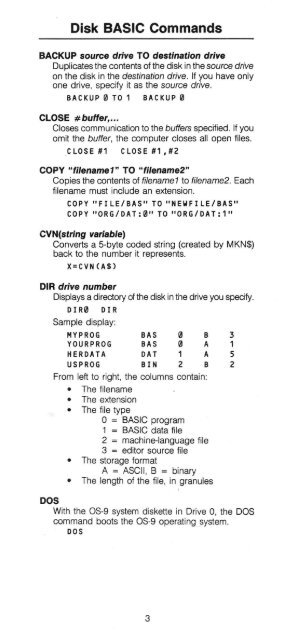Color Computer Disk System - Quick Reference Guide (Tandy).pdf
Color Computer Disk System - Quick Reference Guide (Tandy).pdf
Color Computer Disk System - Quick Reference Guide (Tandy).pdf
You also want an ePaper? Increase the reach of your titles
YUMPU automatically turns print PDFs into web optimized ePapers that Google loves.
<strong>Disk</strong> BASIC Commands<br />
BACKUP source drive TO destination drive<br />
Duplicates the contents of the disk in the source drive<br />
on the disk in the destination drive. If you have only<br />
one drive, specify it as the source drive.<br />
BACKUP 0 TO 1 BACKUP 0<br />
CLOSE # buffer, ...<br />
Closes communication to the buffers specified. If you<br />
omit the buffer, the computer closes all open files.<br />
CLOSE#1<br />
CLOSE#1,#2<br />
COPY "fllename1" TO "fllename2"<br />
Copies the contents of filename 1 to filename2. Each<br />
filename must include an extension.<br />
COPY "FILE/BAS" TO "NEWFILE/BAS"<br />
COPY "ORG/DAT:0" TO "ORG/DAT:1"<br />
CVN(strlng variable)<br />
Converts a 5-byte coded string (created by MKN$)<br />
back to the number it represents.<br />
X=CVN(A$)<br />
DIR drive number<br />
Displays a directory of the disk in the drive you specify.<br />
DIR0<br />
DIR<br />
Sample display:<br />
MYPROG BAS 0 B 3<br />
YOURPROG BAS 0 A 1<br />
HERDATA OAT 1 A 5<br />
USPROG BIN 2 B 2<br />
From left to right, the columns contain:<br />
• The filename<br />
• The extension<br />
• The file type<br />
°= BASIC program<br />
1 = BASIC data file<br />
2 = machine-language file<br />
3 = editor source file<br />
• The storage format<br />
A = ASCII, B = binary<br />
• The length of the file, in granules<br />
DOS<br />
With the OS-9 system diskette in Drive 0, the DOS<br />
command boots the OS-9 operating system.<br />
DOS<br />
3

















